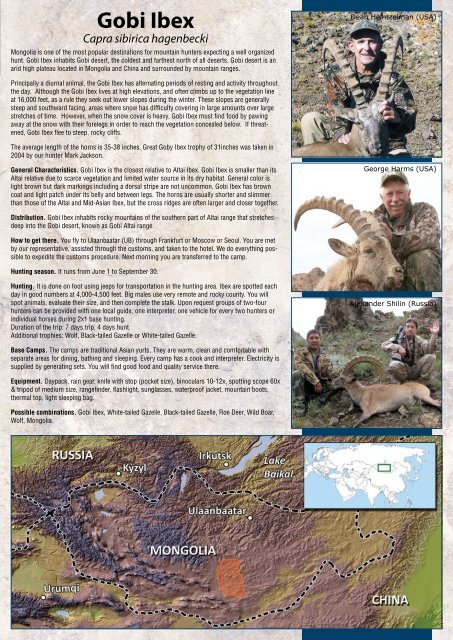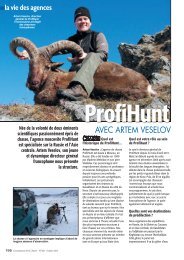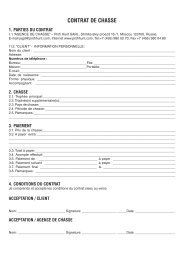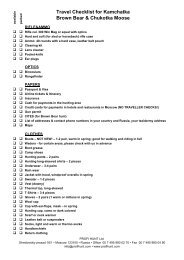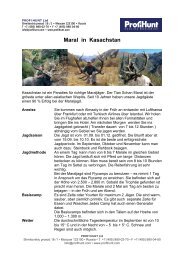Create successful ePaper yourself
Turn your PDF publications into a flip-book with our unique Google optimized e-Paper software.
Gobi Ibex<br />
Capra sibirica hagenbecki<br />
Mongolia is one of the most popular destinations for mountain hunters expecting a well organized<br />
hunt. Gobi Ibex inhabits Gobi desert, the coldest and farthest north of all deserts. Gobi desert is an<br />
arid high plateau located in Mongolia and China and surrounded by mountain ranges.<br />
Principally a diurnal animal, the Gobi Ibex has alternating periods of resting and activity throughout<br />
the day. Although the Gobi Ibex lives at high elevations, and often climbs up to the vegetation line<br />
at 16,000 feet, as a rule they seek out lower slopes during the winter. These slopes are generally<br />
steep and southward facing, areas where snow has difficulty covering in large amounts over large<br />
stretches of time. However, when the snow cover is heavy, Gobi Ibex must find food by pawing<br />
away at the snow with their forelegs in order to reach the vegetation concealed below. If threatened,<br />
Gobi Ibex flee to steep, rocky cliffs.<br />
The average length of the horns is 35-38 inches. Great Goby Ibex trophy of 31inches was taken in<br />
2004 by our hunter Mark Jackson.<br />
General Characteristics. Gobi Ibex is the closest relative to Altai Ibex. Gobi Ibex is smaller than its<br />
Altai relative due to scarce vegetation and limited water source in its dry habitat. General color is<br />
light brown but dark markings including a dorsal stripe are not uncommon. Gobi Ibex has brown<br />
coat and light patch under its belly and between legs. The horns are usually shorter and slimmer<br />
than those of the Altai and Mid-Asian Ibex, but the cross ridges are often larger and closer together.<br />
Distribution. Gobi Ibex inhabits rocky mountains of the southern part of Altai range that stretches<br />
deep into the Gobi desert, known as Gobi Altai range.<br />
How to get there. You fly to Ulaanbaatar (UB) through Frankfurt or Moscow or Seoul. You are met<br />
by our representative, assisted through the customs, and taken to the hotel. We do everything possible<br />
to expedite the customs procedure. Next morning you are transferred to the camp.<br />
Hunting season. It runs from June 1 to September 30.<br />
Hunting. It is done on foot using jeeps for transportation in the hunting area. Ibex are spotted each<br />
day in good numbers at 4,000-4,500 feet. Big males use very remote and rocky county. You will<br />
spot animals, evaluate their size, and then complete the stalk. Upon request groups of two-four<br />
hunters can be provided with one local guide, one interpreter, one vehicle for every two hunters or<br />
individual horses during 2x1 base hunting.<br />
Duration of the trip: 7 days trip, 4 days hunt.<br />
Additional trophies: Wolf, Black-tailed Gazelle or White-tailed Gazelle.<br />
Base Camps. The camps are traditional Asian yurts. They are warm, clean and comfortable with<br />
separate areas for dining, bathing and sleeping. Every camp has a cook and interpreter. Electricity is<br />
supplied by generating sets. You will find good food and quality service there.<br />
Equipment. Daypack, rain gear, knife with stop (pocket size), binoculars 10-12x, spotting scope 60x<br />
& tripod of medium size, rangefinder, flashlight, sunglasses, waterproof jacket, mountain boots,<br />
thermal top, light sleeping bag.<br />
Possible combinations. Gobi Ibex, White-tailed Gazelle, Black-tailed Gazelle, Roe Deer, Wild Boar,<br />
Wolf, Mongolia.<br />
Dean Heintzelman (USA)<br />
George Harms (USA)<br />
Alexander Shilin (Russia)


